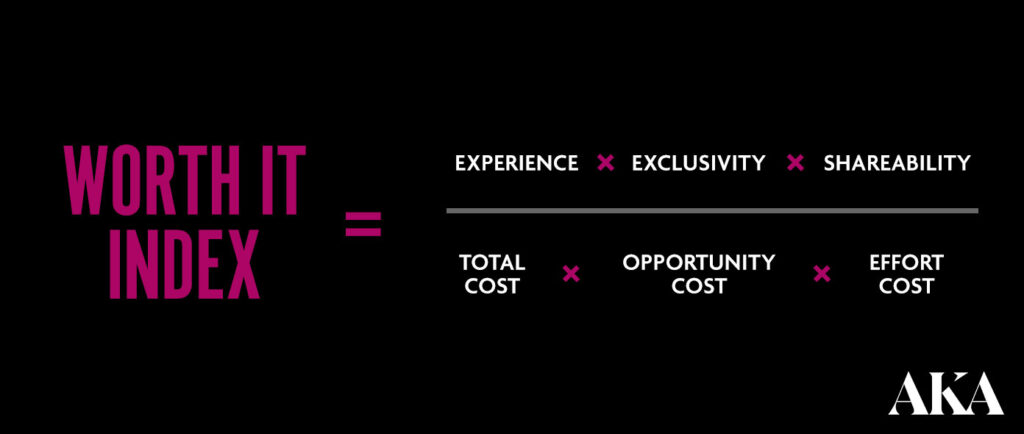Marc Jablonski, Head of Business Intelligence at advertising and marketing firm AKA, explains the company’s “Worth It Index” and its impact on better messaging.
By Marc Jablonski
New York’s cultural sector has been telling itself a comforting story about why suburban audiences are slow to return to the city. As attendance numbers drop and with new NYC congestion pricing due to take effect in mid-June, there are articles and anecdotes that blame safety fears, high costs and the general difficulty of navigating the urban jungle. And it’s true that when they’re asked, suburbanites often cite these factors as the reasons they’re saying home.
But even though that’s what they say, it’s not exactly what they mean. People are notoriously bad at self-reporting their own behavior.
Consider that “The Lion King” made an astonishing $4.3 million during the last week of 2023. Thousands of people came to Times Square for the annual New Year’s Eve ball drop. The Met’s Manet/Degas exhibit last fall was such a blockbuster that visitors had to join a digital queue if they wanted to see it. And throughout the year, musicians as diverse as Bruce Springsteen, the indie band boygenius and the DJ John Summit sold out Madison Square Garden.
When people really want to do something, their concerns fly out the window. They just have to believe an event is worth it.
So how does a live experience reach that threshold? Try plotting it on the “Worth It Index,” which AKA uses to assess the appeal of live events and attractions.

The Worth It Index (above) plots perceived value against perceived costs. Simply put, when value outweighs costs, the experience is worth it. When it doesn’t? Well… audiences are more likely to stay home.
Let’s dig into the formula.
Costs
Audiences can be intimidated by “total cost,” which not only includes the money spent on tickets, it also factors in line items like childcare, travel, dinner and all other factors.
On top of that, potential visitors also consider “opportunity cost,” which includes safety risks and a sense of feeling welcomed at a venue or event. Finally, they weigh their “effort costs,” such as traffic, distance from home and ease of buying a ticket. All of these — the hard financial costs, the opportunity costs and the effort costs — are calculated for a total value that we use in the formula to determine the Worth It Index.
Value
There are three primary values that can make these costs seem worthwhile: experience, exclusivity and shareability.
Experience: If audiences expect they’ll enjoy a performance, an attraction or an event, then they will want to go. It’s as simple as that. They need to believe that what they’re going to see will be more engaging, entertaining, or thought provoking than whatever show they might stream at home. AKA conducts audience surveys asking how much they enjoyed an event and how much they expected they would enjoy an event. We convert the resulting qualitative responses to quantitative data and then determine the experience value on a scale from 1-10 (with 10 being the highest and most desirable score).
Exclusivity: It’s also important for audiences to feel they can’t find the live experience anywhere else. If something is open for a limited time, features an element that won’t always be there or somehow requires live attendance, then it will feel exclusive. The live experience must feel distinct from something that can be enjoyed at home. We determine this by looking at inventory for a live event and, again, rate the exclusivity value on a scale from 1-10 (with 10 being the highest and most exclusive score).
Shareability: People naturally want to spread news. Sometimes, shareability means social media engagement, but other times shareability is about good, old-fashioned word of mouth. Whether it’s online or around the dinner table, audiences will be more likely to attend a live experience if they feel it will give them something to talk about with their community. This factor is a combination of how much has already been shared on social media about an experience and how much can be shared, based on the number of followers of different entities connected to the experience. A scale from 1-10 marks the shareability value (with 10 being the highest and most sharable score).
Once we have numbers assigned to these factors (cost, experience, exclusivity and shareability) we calculate an average: the Worth It Index. Our goal is to achieve a score over 100 percent, which indicates the experience is worth it.
So how do we use this in planning?
As producers, venue owners and operators, marketers and creatives, we must ensure that our experiences are entertaining, exclusive and shareable. Just as important, we need to communicate that value in every media touchpoint, from emails to social posts to television commercials to influencer partnerships and beyond.
That means we must not only explain clearly what the experience is (and what it isn’t), but how it will make guests feel. It means speaking, looking and behaving in a way that justifies the cost (real and perceived) of tickets and babysitters and Ubers. It means giving people a reason to buy now. And it means capturing their imagination — allowing them to see themselves having the experience and planting the story in their minds that they will have to share it after. Above all, it means eliciting an emotional reaction from potential audiences that promises to outweigh the costs of leaving the house.
Audiences aren’t scared to return to the city, nor do they spend less on entertainment when they really want to see something. We just need to show them that our experiences are, indeed, worth it.